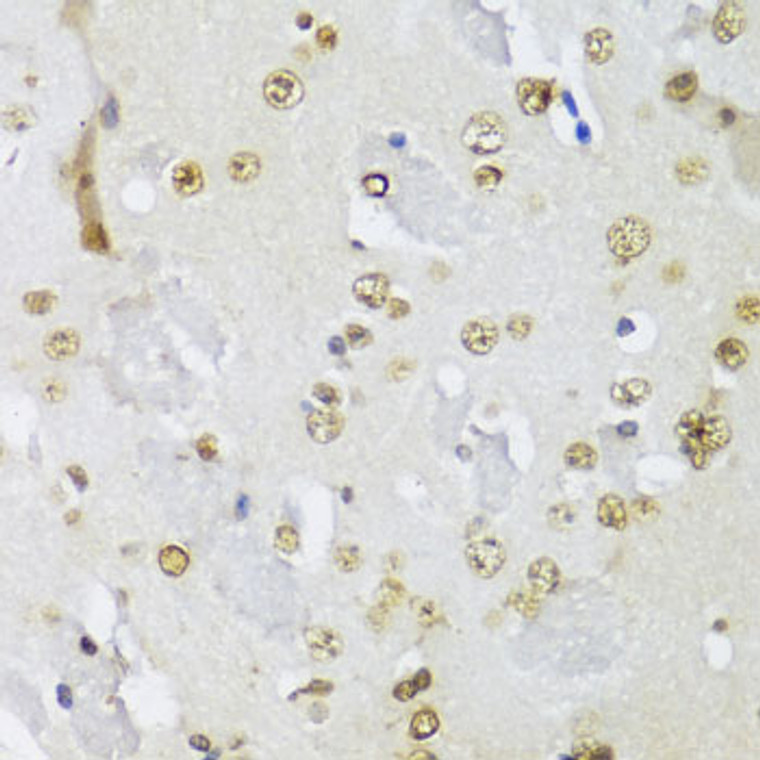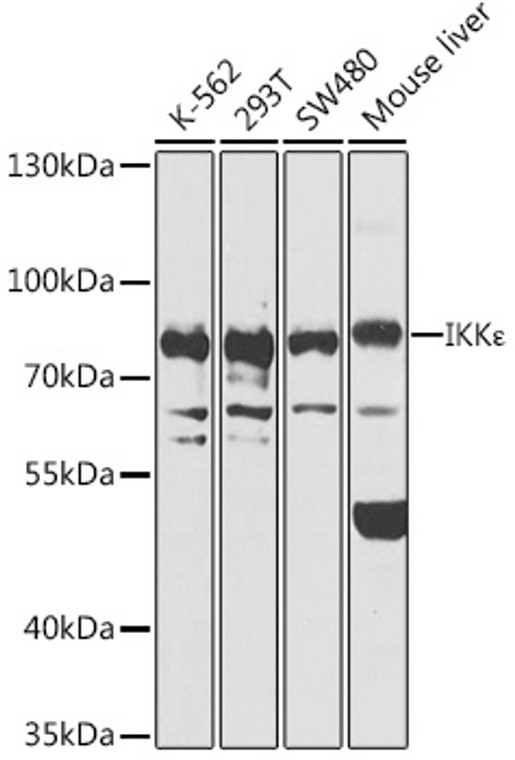| Host: |
Rabbit |
| Applications: |
WB/IHC |
| Reactivity: |
Human/Mouse/Rat |
| Note: |
STRICTLY FOR FURTHER SCIENTIFIC RESEARCH USE ONLY (RUO). MUST NOT TO BE USED IN DIAGNOSTIC OR THERAPEUTIC APPLICATIONS. |
| Short Description: |
Rabbit polyclonal antibody anti-IKK Epsilon (495-716) is suitable for use in Western Blot and Immunohistochemistry research applications. |
| Clonality: |
Polyclonal |
| Conjugation: |
Unconjugated |
| Isotype: |
IgG |
| Formulation: |
PBS with 0.02% Sodium Azide, 50% Glycerol, pH7.3. |
| Purification: |
Affinity purification |
| Dilution Range: |
WB 1:500-1:2000IHC-P 1:50-1:200 |
| Storage Instruction: |
Store at-20°C for up to 1 year from the date of receipt, and avoid repeat freeze-thaw cycles. |
| Gene Symbol: |
IKBKE |
| Gene ID: |
9641 |
| Uniprot ID: |
IKKE_HUMAN |
| Immunogen Region: |
495-716 |
| Immunogen: |
Recombinant fusion protein containing a sequence corresponding to amino acids 495-716 of human IKK Epsilon (NP_054721.1). |
| Immunogen Sequence: |
LRSRLRTLAEVLSRCSQNIT ETQESLSSLNRELVKSRDQV HEDRSIQQIQCCLDKMNFIY KQFKKSRMRPGLGYNEEQIH KLDKVNFSHLAKRLLQVFQE ECVQKYQASLVTHGKRMRVV HETRNHLRLVGCSVAACNTE AQGVQESLSKLLEELSHQLL QDRAKGAQASPPPIAPYPSP TRKDLLLHMQELCEGMKLLA SDLLDNNRIIERLNRVPAPP DV |
| Tissue Specificity | Highly expressed in spleen followed by thymus, peripheral blood leukocytes, pancreas, placenta. Weakly expressed in lung, kidney, prostate, ovary and colon. |
| Post Translational Modifications | Autophosphorylated and phosphorylated by IKBKB/IKKB. Phosphorylation at Ser-172 is enhanced by the interaction with DDX3X. Phosphorylated at Thr-501 upon IFN activation. Sumoylation by TOPORS upon DNA damage is required for protection of cells against DNA damage-induced cell death. Desumoylated by SENP1. 'Lys-63'-linked polyubiquitinated at Lys-30 and Lys-401 by TRAF2:BIRC2 and TRAF2:BIRC3 complexes. Ubiquitination is induced by LPS, TNFA and interleukin-1 and required for full kinase activity and KF-kappa-B pathway activation. |
| Function | Serine/threonine kinase that plays an essential role in regulating inflammatory responses to viral infection, through the activation of the type I IFN, NF-kappa-B and STAT signaling. Also involved in TNFA and inflammatory cytokines, like Interleukin-1, signaling. Following activation of viral RNA sensors, such as RIG-I-like receptors, associates with DDX3X and phosphorylates interferon regulatory factors (IRFs), IRF3 and IRF7, as well as DDX3X. This activity allows subsequent homodimerization and nuclear translocation of the IRF3 leading to transcriptional activation of pro-inflammatory and antiviral genes including IFNB. In order to establish such an antiviral state, IKBKE forms several different complexes whose composition depends on the type of cell and cellular stimuli. Thus, several scaffolding molecules including IPS1/MAVS, TANK, AZI2/NAP1 or TBKBP1/SINTBAD can be recruited to the IKBKE-containing-complexes. Activated by polyubiquitination in response to TNFA and interleukin-1, regulates the NF-kappa-B signaling pathway through, at least, the phosphorylation of CYLD. Phosphorylates inhibitors of NF-kappa-B thus leading to the dissociation of the inhibitor/NF-kappa-B complex and ultimately the degradation of the inhibitor. In addition, is also required for the induction of a subset of ISGs which displays antiviral activity, may be through the phosphorylation of STAT1 at 'Ser-708'. Phosphorylation of STAT1 at 'Ser-708' seems also to promote the assembly and DNA binding of ISGF3 (STAT1:STAT2:IRF9) complexes compared to GAF (STAT1:STAT1) complexes, in this way regulating the balance between type I and type II IFN responses. Protects cells against DNA damage-induced cell death. Also plays an important role in energy balance regulation by sustaining a state of chronic, low-grade inflammation in obesity, wich leads to a negative impact on insulin sensitivity. Phosphorylates AKT1. |
| Protein Name | Inhibitor Of Nuclear Factor Kappa-B Kinase Subunit EpsilonI-Kappa-B Kinase EpsilonIkk-EIkk-EpsilonIkbkeInducible I Kappa-B KinaseIkk-I |
| Database Links | Reactome: R-HSA-4755510Reactome: R-HSA-5357786Reactome: R-HSA-5357905Reactome: R-HSA-9013973Reactome: R-HSA-918233Reactome: R-HSA-933541Reactome: R-HSA-936440Reactome: R-HSA-936964Reactome: R-HSA-9692916Reactome: R-HSA-9705671 |
| Cellular Localisation | CytoplasmNucleusPml BodyTargeting To Pml Nuclear Bodies Upon Dna Damage Is Topors-DependentLocated Diffusely Throughout The Cytoplasm But Locates To Punctate Cytoplasmic Bodies When Coexpressed With Trim6 |
| Alternative Antibody Names | Anti-Inhibitor Of Nuclear Factor Kappa-B Kinase Subunit Epsilon antibodyAnti-I-Kappa-B Kinase Epsilon antibodyAnti-Ikk-E antibodyAnti-Ikk-Epsilon antibodyAnti-Ikbke antibodyAnti-Inducible I Kappa-B Kinase antibodyAnti-Ikk-I antibodyAnti-IKBKE antibodyAnti-IKKE antibodyAnti-IKKI antibodyAnti-KIAA0151 antibody |
Information sourced from Uniprot.org
12 months for antibodies. 6 months for ELISA Kits. Please see website T&Cs for further guidance









